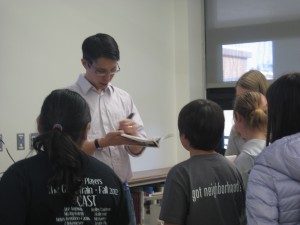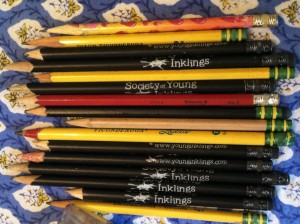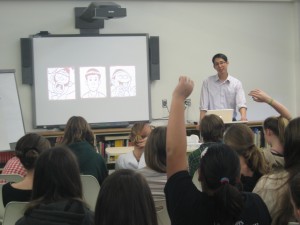How to Learn How to Write
June 6, 2013 | Posted in Blog: Story Stories, teaching | By Kristin
Comments Off on How to Learn How to Write
For three years, I’ve been teaching writing to kids all around Silicon Valley. My students have ranged in age from five to fourteen. I’ve also spent a good amount of time – two years – watching adults learn how to write, since I earned my MFA in Writing for Children and Young Adults.
You could say I’ve spent my last five years learning how to learn to write. When I tell people in casual conversations I am a Writer and a Writing Teacher, I often get a fake smile in return, or a more honest, “I always hated writing.”
Lots of people of all ages say they dislike writing.
However, over the last few years of writing classes with kids – and adults – that has not been my experience. Once people have the opportunity to write freely, they often love it.
Over my last few years, I’ve seen Kindergarteners run to class, second graders write novellas, fourth graders outline and write multiple novels, and teenagers suggest meeting together to write – with their free time.
When writing class is fun, anything can happen. Kids can wish everyday were writing class and they write every night instead of watching TV. A second grader can write a true story about a friend who survived a frightening trip to the hospital. A fourth grader can go from weeping at the sight of a notebook to claiming writing as her favorite subject.
Third graders can create entire worlds. Kindergarteners can imagine visiting the moon and Mars. First graders can write a story so sad and scary it will haunt your dreams. Fourth graders can create intricate fantasy worlds, characters who inhabit them, share those worlds and characters with each other, and write highly entertaining stories consistent with those settings. Teenagers can write poetry, realistic fiction, fantasy and science fiction that will make you laugh and think; worthy of publication. This world is full of young and gifted writers.
And it’s easy to nurture them.
First of all, you’ll need a lot of pencils.
After that, I think it boils down to four things pretty simple things: fun, friends, seeds and cookies.
I’m taking the pencils for granted. Those would be element number five. My next four days of blog posts will be dedicated fun, friends, seeds and cookies. I don’t have much to say about pencils, other than: Keep them out of your neighbor’s eye, please.
Gene Luen Yang Visits Hillview
February 28, 2013 | Posted in Blog: Story Stories, teaching | By Kristin
What is a soul? How much can people change? How can a person’s family be oblivious to his complete transformation?
These are questions Hillview seventh graders asked recently while reading Gene Luen Yang’s Printz-winning graphic novel American Born Chinese.
The novel was based on Yang’s experience growing up in the Bay Area. Tuesday, he spoke with the students about his novel. Once they heard about the origins of the three story lines in the book, their questions transformed.
They got personal.
Especially when they discovered that the character Jin Wang had a childhood similar to Yang’s. Did you grow up in the Bay Area? Did that really happen to you? Did someone really say that to you? Did you do something like that?
Yang’s honest answers helped these seventh graders understand how good fiction is created: from real experiences. Yang also shared the origins of the other complex story lines in American Born Chinese.
Yang shared the many iterations of the popular character The Monkey King. As a boy, he heard stories about The Monkey King practically nightly. Yang’s own Monkey King is shoeless; a difference based on his own childhood conversations with his mother – and important to the book.
The third story line – that of Chin Kee – raised the most questions as the students read the book. This character also originally caused the book’s exclusion from some bookstores. However, once Yang wrote an essay describing the origins of Chin Kee – and people had time to read through American Born Chinese – the novel came to be embraced. Chin Kee is an amalgamation of the stereotypes with which Yang was surrounded. As Yang told the seventh graders, “If you don’t accept your heritage, you end up becoming a stereotype.”

Yang signs autographs
At the end of his presentation – and at the close of school – Yang was surrounded for more gracious Q & A and autograph signing. It didn’t hurt that his most recent books were Avatar.
The program, Author Author, was funded by a Jeanie Ritchie Grant from the Menlo Park-Atherton Education Foundation and sponsored by Hillview librarian Tracy Piombo. Kristin Aker Howell works for the Society of Young Inklings.
A Christmas Voodoo Story
November 15, 2012 | Posted in Blog: Story Stories, Book Reviews | By Kristin
The holidays seem created to cause conflict. Families gather. Beliefs differ, but cannot be concealed. Time, resources, and patience are limited. It’s enough to tempt anyone to make a small, wax figurine of a powerful family figure, just to have it go along with the holiday plans.
That’s precisely what six-year-old Toad does in Mrs. Coverlet’s Magicians by Mary Nash. And, who can blame the boy for trying voodoo? Miss Eva was planning to make eggplant and rutabaga for dinner. His beloved Mrs. Coverlet, who had just left for a national baking competition, would never feed him such outlandish vegetables.
I read this book at the recommendation of Deborah Underwood, author of The Christmas Quiet Book. She re-reads the book – a treasured one from her childhood – each Christmas, maybe not for the voodoo per se.
Mrs. Coverlet’s Magicians deals with belief in many forms. The youngest brother believes in just about everything: the power of the magic kit he bought from the horror comic and Santa. Malcolm, the oldest brother, is more skeptical, not even believing that Mrs. Coverlet’s recipe could win a contest.
This clash of beliefs is a situation set for conflict, as are most family holidays. But, in Mrs. Coverlet’s Magicians, the kids end up helping each other. Underwood says:
I respond to the love they all have for each other. The kids’ willingness to endure Miss Eva for the sake of Mrs. Coverlet’s big chance, Malcolm and Molly’s determination to have a normal Christmas for their little brother, and even Miss Dextrose-Chesapeake’s outrage at Mrs. Coverlet’s plight and her willingness to intervene–these things truly exemplify the Christmas spirit for me.
Of course, the Toad’s way of helping resembles voodoo. He makes a wax figurine of Miss Eva and puts it to bed. He uses a wand to find a Christmas tree and casts spells each night so that it will snow on Christmas.
These actions concern Malcolm – Underwood most identifies with him – and his “troublesome conscience.” Malcolm takes care of everything. He burns the horror comic they weren’t allowed to read, buys gifts for his brother and sister, and undoes the voodoo doll. Then Malcolm speaks to the Reverend, their neighbor, about what it all means. Underwood points out:
I adored that Reverend Forthright was perfectly willing to accept all the strange happenings as Christmas magic, and that he told Malcolm to enjoy the mystery of it all rather than fret about it.
Not many books deal so directly with a variety of beliefs and the doubts that naturally accompany belief. Malcolm’s confession to Reverend Forthright leads to clarity. Reverend Forthright says:
“I believe in magic at Christmas…the amount of good will which is set loose every year at this time is quite unaccountable. Take your spruce! I don’t care how the Toad found it! What good were his spells and his wand if Mr. Bouncer hadn’t let you keep it, even helped you home with it!…Let the Toad think he conjured up Christmas single-handed. You and I know how many people contributed.”
Malcolm’s fears are calmed and he can enjoy his little brother at the end of the book. Dialogue and conflict about faith and life can help readers discern their own beliefs. Despite their significant differences, the characters in Mrs. Coverlet’s Magicians ultimately help each other. Underwood reflects on the theme of the book:
I did and still do believe in Christmas magic, although possibly more in the Reverend Forthright sense than in the magic-kit-ordered-from-horror-comic sense.
There are no wax figures in Underwood’s newest book, The Christmas Quiet Book. But there are characters overcoming some differences, and sticking together during tense holiday times. Perhaps that is the real Christmas voodoo.
A September 11 Story
September 11, 2012 | Posted in Blog: Story Stories, Book Reviews | By Kristin
I am lucky. My daughters were nowhere near New York, Washington D.C. or Shanksville on September 11, 2001. They were in Nursery School in California. Outside their school that morning, a sign was posted which read:
Today something terrible has happened to our country. Please help us keep this tragedy outside our gates. This place is a refuge for our children to play. They want to learn. They cannot understand the events going on. Keep their routine the same, even as we all grieve the tremendous loss our country is suffering.
At some point in the afternoon my four-year-old asked what her Dad and I were talking about. We had begun to chat in the front seat of the car, oblivious to her attention. I struggled with how to explain the attacks. Should I ignore her question? What would exposing her to such darkness do?
Rather than distract her, I said, “Our country was attacked.”
She asked a lot of excellent questions. I remember saying, at some point, the attacks happened “because we are a free country.” That, although true in many ways, was an altogether unhelpful answer for a four-year-old. I thought speaking in generalities might lessen her fear. And I didn’t want either of us to imagine that much pain.
That night, as I wondered if we would ever board an airplane again, I followed our usual routine. My daughters and I got into bed and read books. Goodnight Gorilla, by Caldecott-Award winning author-illustrator Peggy Rathmann, was our favorite book at that time.
Gorilla wanted freedom. He wanted out of his cage. He wanted his friends free too. What we loved was Gorilla’s ingenuity – he snagged the keys – his persistence and joyful disobedience in pursuit of his goal. Ultimately, as we were, Gorilla was looking for comfort. He kept crawling into bed. My girls loved the page where the lights were turned out and all eyes (including ours) suddenly went wide when the Zookeepers wife finally saw everyone who was in bed.
For us, that night appeared like any other.
But September 11 changed us all, even those of us several times zones away. I couldn’t always keep them inside the Nursery School gates.
On our TVs, we saw tragedy in the sun setting behind the silhouettes of the fallen towers. We saw true beauty in all the stories that began to come out about the rescue workers, Flight 93, and all the families. We understood freedom, sacrifice, responsibility, safety and love of our countrymen in a new way. I knew I hadn’t translated that into four-year-old.
In the intervening time, however, Peggy Rathmann has. She wrote and illustrated The Day the Babies Crawled Away. In this book, the babies want freedom. They want to discover the miraculous butterflies that traverse their picnic.
Parents are eating pie and chatting, obliviously. The babies leave, following the butterflies. They want to learn and play. The busy parents don’t see. They probably can’t imagine – or don’t want to imagine – the things that are about to happen to their kids.
But a young boy, wearing a firefighter’s helmet, notices. He can imagine. Maybe he even worries. He follows the babies while they chase bees, frogs, crawl out on ledges, and practically fly. At the very least, the babies might get stung. For those of us ready to understand, we know the babies want to fly, but don’t see the risk.
Thankfully, the boy catches the babies, scrambles down a cliff, feeds them mashed blackberries, then fashions a sling out of diapers to get them home up the cliff. His ingenuity, his bravery, his imagination, his care and attention saved the babies.
I asked Peggy Rathmann, in 2007, about The Day the Babies Crawled Away. She said,
“I’d been mulling the general idea of a heroic but tender young person leading a band of babies to safety but I didn’t begin writing and drawing until shortly after September 11, 2001. The hero wears a firefighter’s helmet in honor of the search and rescue workers who died that day.”
The illustrations in the book are silhouettes. All of the light comes from the setting sun. We only see the characters in relation to each other and to space and time. Once the boy finally returns to sleep in his mother’s arms, his home – and others – is lit from inside.
The Day the Babies Crawled Away faces those fears I hesitate to imagine. Children wander off to learn and play. Their lives can be at stake when they don’t know it. I can easily chat away, obviously, especially if there’s pie.
And my daughters are now teenagers. Thankfully, they pay attention and tend to follow wayward toddlers.


